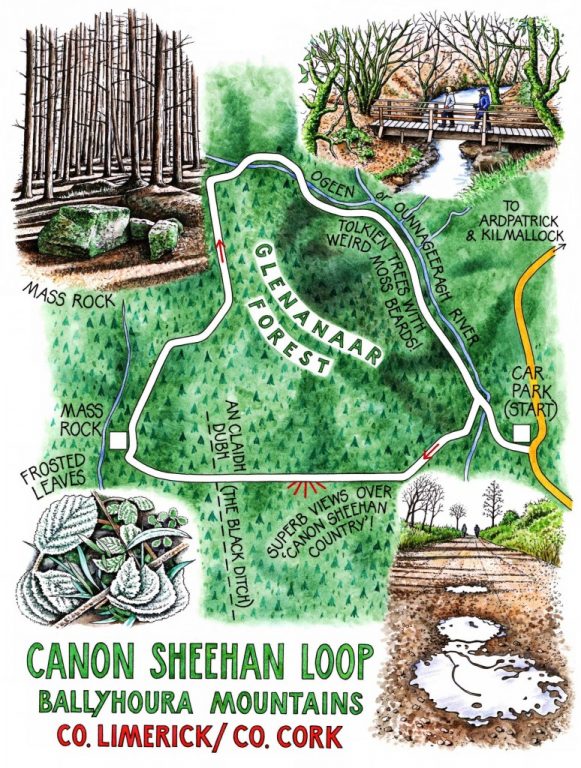Irish Independent – WALK OF THE WEEK – Christopher Somerville
6 March 2010
49. Canon Sheehan Loop, Ballyhoura Mountains
Cos. Limerick and Cork

‘Glenanaar, the glen of slaughter, is a deep ravine, running directly north and south through a lower spur of the mountains that divide Cork and Limerick.’ So wrote Canon Patrick Augustine Sheehan in his novel Glenanaar, published in 1905 when the Mallow-born author had been ten years the parish priest of Doneraile. Canon Sheehan might be largely overlooked these days, but his name and fame still resonate around Doneraile and in the Ballyhoura mountains whose landscape and people he depicted with humour and humanity in a long string of books.
What Ballyhoura is celebrated for these days is walking. Ballyhoura International Walking Festival is one of the showpieces of Irish walking, and the Ballyhoura Bears walking club has a well-earned reputation for combining hiking and craic to delectable effect. It was Cal McCarthy, a dedicated Bear and knowledgeable Patrick Sheehan fan, who volunteered to show us around the Canon Sheehan Loop, a superb walk through Glenanaar Forest in the southern ranges of Ballyhoura.
Walking the forest track, we gazed south over ‘Canon Sheehan Country’. The vale around Doneraile and Kildorrery lay low, its frosted hills riding like islands in a smoky sea of mist. Canon Sheehan brought out just this wintry aspect in Glenanaar: ‘As the weather was intensely cold, there were none of the usual thaws, but the frost knit the snow-flakes together and crusted them all over with its own hard but brilliant enamelling. The white level plain stretched its monotone of silver till it touched the sky-line, and was merged in it.’
The outstretched hand of Cal indicated the line of an ancient trackway, an icy streak of silver making like an arrow for the distant Nagle Mountains. ‘An Claidh Dubh, the Black Ditch,’ said our guide. ‘It’s been traced a long way. Iron Age, perhaps? A boundary, but between who or what?’ He smiled. ‘There’s just so much we don’t know about what’s in our land – which just feeds the old curiosity!’
We turned across the hill and came to a mossy old Mass Rock, three-sided and massive, lying under the trees. Rumours of a priest shot while praying here, tales of his burial under a pile of stones on the banks of the Ogeen River. Down there we encountered ancient broadleaved trees bearded and coiffed with frozen mosses, unearthly snow formations like arctic candyfloss, and the cold exhalations of the Ogeen as it rushed over its sandstone bed.
Patrick Sheehan was a quiet man, by all accounts, but he wasn’t afraid to promulgate land reform, education, political freedom and inter-faith co-operation. Through his eyes we see the old Irish countrymen ‘in their strong frieze cutaway coats, their drab or snuff-coloured vests and knee-breeches, the rough home-woven stockings, and the strong shoes – all made, like themselves, for hard work and wild tempestuous weather.’ Sheehan lamented in Glenanaar: ‘No Wordsworth has yet sung the praises of these Irish dalesmen’. He himself did the job – superbly, too.
As we crossed the Ogeen River and came up the ice-puddled track, we puzzled over the slaughter that gave Glenanaar its ominous name. Bard Ossian tells of a great battle between Clann Morna and Clann Baskin at the Ford of Light on the Ounnageeragh or Ogeen River. Was it that ancient blood-letting? Then what of ‘The Battle of the Raven’s Glen’, the ballad that describes O’Sullivan Beare ambushing a force of ‘Saxons and kerns from the wilds of Duhallow’ on the same spot?
Then O’Sullivan burst like the angel of slaughter,
On the foe by the current of Geeragh’s wild water,
And his brave men of Cork and of Kerry’s wild regions
Were the rushing destroyers, his death-dealing legions;
And onward they rode over traitor and craven,
Whose bones long bestrewed the lone Glen of the Raven.
That’s as close as we’re likely to get to what actually happened in Glenanaar – if indeed anything happened at all. You know what story-tellers are like.
WAY TO GO
MAP: OS of Ireland 1:50,000 Discovery 73; downloadable map/instructions (highly recommended) at www.discoverireland.ie/walking.
TRAVEL: From Kilmallock, R512 Kildorrery road. 2 km beyond Ardpatrick, right (brown ‘Ballyhoura Forest’ sign). In 4 miles, ‘Ballyhoura-Glenanair’ sign points right to forest car park.
WALK DIRECTIONS (Canon Sheehan Loop/CSL – blue arrows): Pass striped pole; down track; cross Ogeen River. NB This walk follows CSL in reverse! Ignore CSL arrows to right; keep ahead left, up track to T-junction at top. Left (purple arrow/PA); follow track along hillside. In 1½ miles, where track begins to descend, right (CSL, PA) up rising track. In 100 m, pass Mass Rock (signposted left); continue ½ mile, descending to cross tracks and continue down to cross river. Turn right beside river, soon recrossing to right bank. In ⅔ mile, pass ‘Mass Rock’ fingerpost/CSL on right; in another ¼ mile, at next ‘Mass Rock’/CSL/PA, left down bank; path to recross footbridge; track to car park.
LENGTH: 5 miles: allow 2-2½ hours
GRADE: Moderate
CONDITIONS: Forest tracks
DON’T MISS … !
• fantastic views over ‘Canon Sheehan Country’
• the Mass Rock
• Tolkien-like trees by the Ogeen River
REFRESHMENTS: picnic
ACCOMMODATION: Deebert House Hotel, Kilmallock (063-31200; www.deeberthousehotel.com) – very walker-friendly and welcoming
BALLYHOURA WALKING FESTIVAL: 1 – 3 May 2010
INFORMATION: Walking tour operators, local walks including Discover Ireland’s National Loop Walks, walking festivals throughout Ireland: www.discoverireland.ie/walking; www.coillteoutdoors.ie
Tinahely Trail Walking Festival, Co Wicklow, 17-18 April 2010: www.tinahely.ie (email tinahelywalkerswelcome@eircom.net)
INFORMATION:
Ballyhoura Fáilte Tourist Information Office: Kilfinane, Co Limerick (063-91300); www.ballyhouracountry.com
csomerville@independent.ie